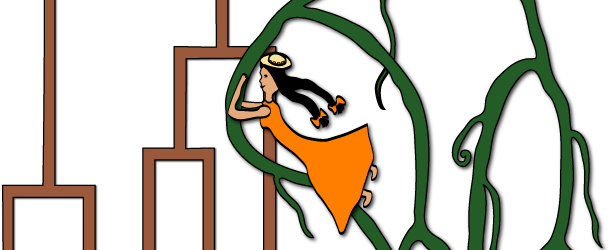
Jane's Cost Models and Events
Cophylogeny reconstruction attempts to find a mapping of the parasite tree onto the host tree assuming some combination of cospeciation, duplication, duplication with host switching, loss, and failure to diverge events. Each of these five event types has an associated cost that may be specified by the user, and we seek to find a mapping of minimum total cost.
As an example, consider the "tanglegram" below where the host tree is shown in black on the left and the parasite tree is shown in gray on the right. The associations of the tips are shown with dotted lines.

- A cospeciation occurs when the host and parasite speciate simultaneously.
- A duplication occurs when a parasite speciates and both of the new species remain on the same host.
- A duplication and host switch occurs when a parasite speciates and one of the new species switches onto a different host.
- A loss occurs when an edge of the parasite tree passes through a node of the host tree.

How solution costs are computed
Jane attempts to find solutions that minimize the total sum of the event costs. Note that duplication and host switch is one event type and it has cost that is set separately from duplication. In general, one would expect that the former event type would be more expensive than the latter, but it is up to the user to set the costs.
The default setting in the GUI version of Jane is called the "node based" cost model. In this model, each event is billed the cost for that event. In order to be compatible with the TreeMap software package, Jane also supports the option of using the "edge based" cost model. (For historical reasons, the command line version of Jane uses the "edge based" model as the default but there is an option to use the "node based" model.) See the TreeMap page for more information on this model.
Failure to Diverge Events
One feature unique to Jane is the ability to handle failure to diverge events. A failure to diverge occurs when a host speciates and the parasite remains on both new host species. Each failure to diverge event corresponds to a specific parasite failing to diverge. Note that only parasite tips are permitted to fail to diverge in Jane. Moreover, once a parasite tip has failed to diverge, it is no longer permitted to switch hosts. This ensures that Jane will only use a failure to diverge event when absolutely necessary. That is, for a parasite tip to fail to diverge at some host node, it must live on a host tip descending from each child of that host node.
The figure below give an example of a "tanglegram" involving a parasite that lives on multiple hosts and a possible mapping of the parasite tree onto the host tree using failure to diverge events. Note that the host tree is shown in black and the parasite tree in gray. In this example, parasite b fails to diverge along the parasite edge connecting parasite b to parasite c.

It is also possible for parasite tips to fail to diverge along parasite edges that are not tips. The figure below demonstrates this possibility. Here, parasite b fails to diverge along the parasite edge occurring before node c. This implies that node c and its preceding edge are actually the same species as parasite b. In assigning failure to diverge events along some parasite edge, Jane is in effect determining the identity of the parasite species alive at that edge. For this reason, once the identity of an edge is known to be the same as a certain parasite tip, Jane will prevent any other parasite tips from failing to diverge at the same edge.
 Back to Jane Homepage
Back to Jane Homepage